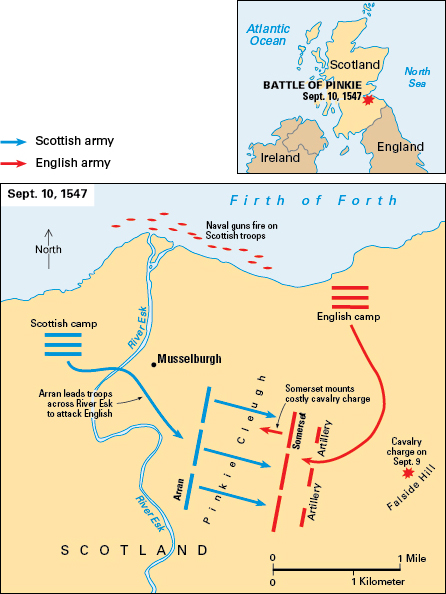Pinkie, Battle of, was a clash between the kingdoms of England and Scotland on Sept. 10, 1547. It took place along the River Esk near Musselburgh, a town just east of Edinburgh, the Scottish capital. The clash, also called the Battle of Pinkie Cleugh, ended in a decisive English victory. Pinkie Cleugh was a lowland central to the battlefield. The battle was the last between the separate kingdoms of England and Scotland, which merged under King James I in 1603.

Beginning in 1543, England’s King Henry VIII tried to force an alliance with Scotland by arranging a marriage between his son Edward and Mary, the infant Queen of Scots. When Henry VIII died in January 1547, Prince Edward (later Edward VI of England) was just 9 years old. Edward’s uncle Edward Seymour, the Duke of Somerset, governed for him as Protector of England.
Still trying to force the marriage, Somerset led an army of some 16,000 troops into Scotland in September 1547. To keep contact with his supporting naval forces, Somerset stayed near the North Sea coast. James Hamilton, the Earl of Arran, was ruling Scotland for young Mary. Arran and more than 20,000 Scottish soldiers met the English invasion at a crossing of the River Esk near Musselburgh.
On September 9, the day before the main battle, English cavalry battered the Scottish cavalry at nearby Falside (or Fa’side) Hill. This reduced the Scottish forces and cleared the way for English artillery to take positions on the high ground surrounding Pinkie Cleugh. At the same time, English warships in the Firth of Forth closed to within range of the Scots on shore. Faced with a huge disadvantage in heavy guns, Arran hoped to win a quick victory by striking first.
On September 10, Scottish troops attacked across the Esk. Somerset stopped the Scottish advance with a costly cavalry charge. English artillery and naval guns then decimated the Scottish troops, forcing them to withdraw from the battlefield. English cavalry mauled the remaining Scots as they bunched up and retreated across the river. By the end of the day, the lopsided English victory was complete.
Historians estimate that more than 5,000 Scottish troops died in the Battle of Pinkie. Another 1,500 were taken prisoner. Around 500 English soldiers died in the fighting.
Somerset destroyed the bulk of the Scottish army at the Battle of Pinkie. The Scots refused to give in, however, and sent Queen Mary to France. There, she wed the young dauphin (crown prince) Francis, heir to the French throne. Two years later, French troops helped drive the English forces from Scotland.
